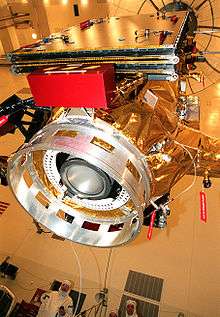NASA Solar Technology Application Readiness
The NASA Solar Technology Application Readiness (NSTAR) is a type of spacecraft ion thruster called electrostatic ion thruster.[1][2] It is a highly efficient low-thrust spacecraft propulsion running on electrical power generated by solar arrays. It uses high-voltage electrodes to accelerate ions with electrostatic forces.

Development and performance

The purpose of NSTAR program was to develop a xenon-fueled ion propulsion system for deep space missions.[3] The NSTAR electrostatic ion thruster was developed at NASA's Glenn Research Center and manufactured by Hughes, and Spectrum Astro, Inc. in the early 1990s. The feed system development was a collaborative effort between JPL and Moog Inc.[1]
The ions are accelerated through two fine grids with roughly a 1300 V difference between them for 2.3 kW operation,[4][5] with a thrust of 20-92 mN, a specific impulse of 19000-30500 N·s/kg (1950-3100 s) and a total impulse capability of 2.65 x106 Ns.[5] In 1996, the prototype engine endured 8000 hours of continuous operation in a vacuum chamber that simulates conditions of outer space. The results of the prototyping were used to define the design of flight hardware that was built for Deep Space 1 probe. One of the challenges was developing a compact and light weight power processing unit that converts power from the solar arrays into the voltages needed by the engine.[3]
The engine achieves a specific impulse of one to three thousand seconds. This is an order of magnitude higher than traditional space propulsion methods, resulting in a mass savings of approximately half. This leads to much lighter and less expensive launch vehicles. Although the engine produces just 92 millinewtons (0.331 ounce-force) thrust at maximum power (2,100W on DS1 mission), the craft achieved high speed because ion engines thrust continuously for long periods of time.[6]
Applications
The NSTAR ion thruster was first used on the Deep Space 1 (DS1) spacecraft, launched on 24 October 1998.[7] The Deep Space mission carried out a flyby of asteroid 9969 Braille and Comet Borrelly. It produced 2.3 kW and was the primary propulsion for the probe.[4]
The second interplanetary mission using NSTAR engine was the Dawn spacecraft, with three redundant units[8] with a 30 cm diameter each.[9][10] Dawn is the first NASA exploratory mission to use ion propulsion to enter and leave more than one orbit.[11]
NASA engineers state that NSTAR engines, in the 5-kilowatt and 0.04 pound-thrust range, are candidates for propelling spacecraft to Europa, Pluto, and other small bodies in deep space.[1]
See also
References
- "NASA Solar Electric Propulsion Technology Application Readiness (NSTAR)". NASA's Glenn Research Center. April 21, 2009. Retrieved 2015-03-18.
- Sovey, J. S., Rawlin, V. K., and Patterson, M. J.: "Ion Propulsion Development Projects in U. S.: Space Electric Rocket Test 1 to Deep Space 1." Journal of Propulsion and Power, Vol. 17, No. 3, May–June 2001, pp. 517-526.
- "Innovative Engines - The NSTAR Program". NASA Glenn Research Center. Retrieved 2015-03-18.
- "NSTAR". Encyclopedia Astronautica. Archived from the original on 2014-02-09. Retrieved 2015-03-18.
- In-flight performance of the NSTAR ion propulsion system on the Deep Space One mission. Aerospace Conference Proceedings. IEEExplore. 2000. doi:10.1109/AERO.2000.878373.
- Rayman, M.D. and Chadbourne, P.A. and Culwell, J.S. and Williams, S.N. (1999). "Mission design for deep space 1: A low-thrust technology validation mission" (PDF). Acta Astronautica. Elsevier. 45 (4–9): 381–388. Bibcode:1999AcAau..45..381R. doi:10.1016/s0094-5765(99)00157-5. Archived from the original (PDF) on 2015-05-09.CS1 maint: multiple names: authors list (link)
- NASA Glenn Contributions to Deep Space 1
- Dawn - Key spacecraft characteristics. 2014.
- Bond, T.; Benson, G.; Cardwell, G.; Hamley, J. (1999-04-06). NSTAR Ion Engine Power Processor Unit Performance: Ground Test and Flight Experience. Aerospace Power Systems Conference. SAE International. doi:10.4271/1999-01-1384.
- NSTAR Ion Engine Xenon Feed System: Introduction to System Design and Development Archived 2016-03-04 at the Wayback Machine. Edward D.Bushway (PDF)
- Rayman, Marc; Fraschetti, Thomas; Raymond, Carol; Russell, Christopher (April 5, 2006). "Dawn: A mission in development for exploration of main belt asteroids Vesta and Ceres" (PDF). Acta Astronautica. 58 (11): 605–616. Bibcode:2006AcAau..58..605R. doi:10.1016/j.actaastro.2006.01.014. Retrieved April 14, 2011.